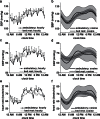Day/night variability in blood pressure: influence of posture and physical activity
- PMID: 23535155
- PMCID: PMC3693479
- DOI: 10.1093/ajh/hpt026
Day/night variability in blood pressure: influence of posture and physical activity
Abstract
Background: Blood pressure (BP) is highest during the day and lowest at night. Absence of this rhythm is a predictor of cardiovascular morbidity and mortality. Contributions of changes in posture and physical activity to the 24-hour day/night rhythm in BP are not well understood. We hypothesized that postural changes and physical activity contribute substantially to the day/night rhythm in BP.
Methods: Fourteen healthy, sedentary, nonobese, normotensive men (aged 19-50 years) each completed an ambulatory and a bed rest condition during which BP was measured every 30-60 minutes for 24 hours. When ambulatory, subjects followed their usual routines without restrictions to capture the "normal" condition. During bed rest, subjects were constantly confined to bed in a 6-degree head-down position; therefore posture was constant, and physical activity was minimized. Two subjects were excluded from analysis because of irregular sleep timing.
Results: The systolic and diastolic BP reduction during the sleep period was similar in ambulatory (-11±2mmHg/-8±1mmHg) and bed rest conditions (-8±3mmHg/-4±2mmHg; P = 0.38/P = 0.12). The morning surge in diastolic BP was attenuated during bed rest (P = 0.001), and there was a statistical trend for the same effect in systolic BP (P = 0.06).
Conclusions: A substantial proportion of the 24-hour BP rhythm remained during bed rest, indicating that typical daily changes in posture and/or physical activity do not entirely explain 24-hour BP variation under normal ambulatory conditions. However, the morning BP increase was attenuated during bed rest, suggesting that the adoption of an upright posture and/or physical activity in the morning contributes to the morning BP surge.
Keywords: ambulatory; bed rest; blood pressure; circadian; hypertension; sleep..
Figures


References
-
- Bevan AT, Honour AJ, Stott FH. Direct arterial pressure recording in unrestricted man. Clin Sci 1969; 36: 329–344 - PubMed
-
- Ben-Dov IZ, Kark JD, Ben-Ishay D, Mekler J, Ben-Arie L, Bursztyn M. Predictors of all-cause mortality in clinical ambulatory monitoring. Hypertension 2007; 49: 1235–1241 - PubMed
-
- Hansen TW, Jeppesen J, Rasmussen S, Ibsen H, Torp-Pedersen C. Ambulatory blood pressure monitoring and risk of cardiovascular disease: a population-based study. Am J Hypertens 2006; 19: 243–250 - PubMed
-
- Fagard RH, Thijs L, Staessen JA, Clement DL, De Buyzere ML, De Bacquer DA. Night-day blood pressure ratio and dipping pattern as predictors of death and cardiovascular events in hypertension. J Hum Hypertens 2009; 23: 645–653 - PubMed
Publication types
MeSH terms
Grants and funding
LinkOut - more resources
Full Text Sources
Other Literature Sources
Medical

